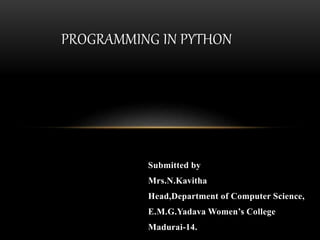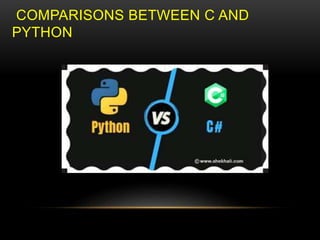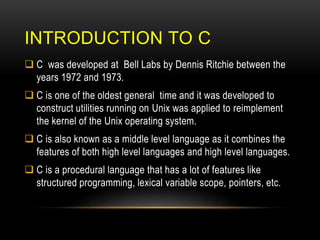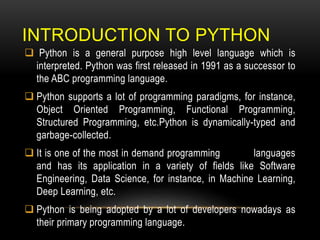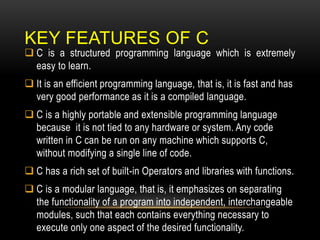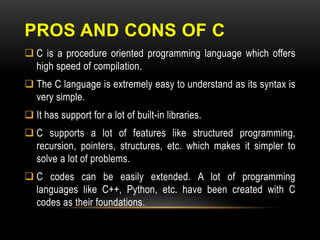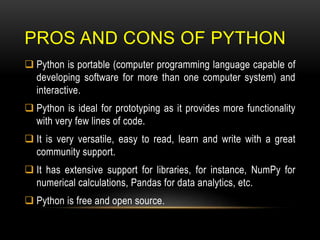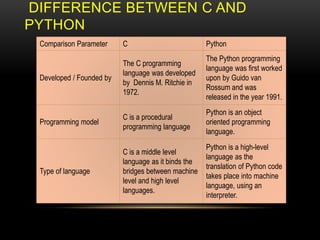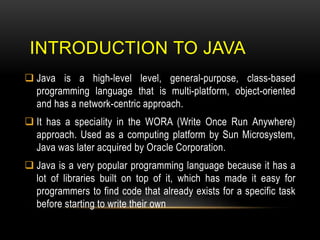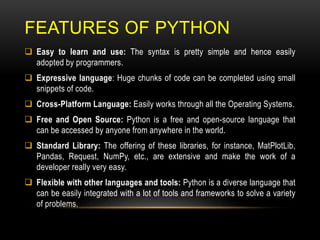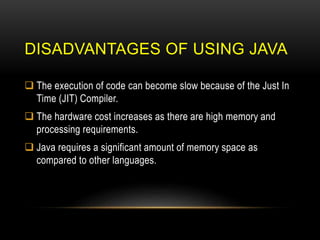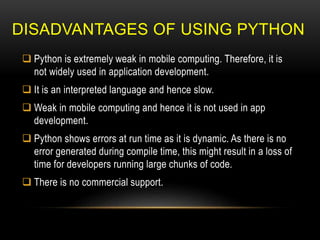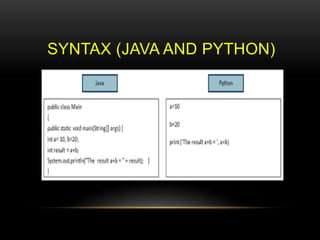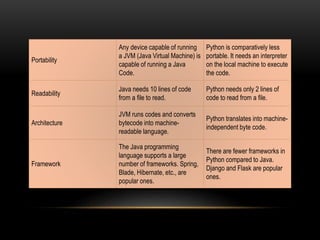Programming in python in detail concept .pptx
- 1. Submitted by Mrs.N.Kavitha Head,Department of Computer Science, E.M.G.Yadava Women’s College Madurai-14. PROGRAMMING IN PYTHON
- 2. COMPARISONS BETWEEN C AND PYTHON
- 3. INTRODUCTION TO C C was developed at Bell Labs by Dennis Ritchie between the years 1972 and 1973. C is one of the oldest general time and it was developed to construct utilities running on Unix was applied to reimplement the kernel of the Unix operating system. C is also known as a middle level language as it combines the features of both high level languages and high level languages. C is a procedural language that has a lot of features like structured programming, lexical variable scope, pointers, etc.
- 4. INTRODUCTION TO PYTHON Python is a general purpose high level language which is interpreted. Python was first released in 1991 as a successor to the ABC programming language. Python supports a lot of programming paradigms, for instance, Object Oriented Programming, Functional Programming, Structured Programming, etc.Python is dynamically-typed and garbage-collected. It is one of the most in demand programming languages and has its application in a variety of fields like Software Engineering, Data Science, for instance, in Machine Learning, Deep Learning, etc. Python is being adopted by a lot of developers nowadays as their primary programming language.
- 5. KEY FEATURES OF C C is a structured programming language which is extremely easy to learn. It is an efficient programming language, that is, it is fast and has very good performance as it is a compiled language. C is a highly portable and extensible programming language because it is not tied to any hardware or system. Any code written in C can be run on any machine which supports C, without modifying a single line of code. C has a rich set of built-in Operators and libraries with functions. C is a modular language, that is, it emphasizes on separating the functionality of a program into independent, interchangeable modules, such that each contains everything necessary to execute only one aspect of the desired functionality.
- 6. KEY FEATURES OF PYTHON Python is a very simple, readable open source programming language which is extremely easy to learn. Python is an interpreted language and not a compiled language. Python also supports the Object Oriented Programming Model. Python is platform independent and easily extensible and embeddable. It has a huge standard library with lots of modules and packages which support a lot of common and important functionalities. Python has one of the largest communities on StackOverflow and Meetup. Python is a high level language as it is easy to use because of simple syntax, powerful because of its rich libraries and extremely versatile.
- 7. PROS AND CONS OF C C is a procedure oriented programming language which offers high speed of compilation. The C language is extremely easy to understand as its syntax is very simple. It has support for a lot of built-in libraries. C supports a lot of features like structured programming, recursion, pointers, structures, etc. which makes it simpler to solve a lot of problems. C codes can be easily extended. A lot of programming languages like C++, Python, etc. have been created with C codes as their foundations.
- 8. PROS AND CONS OF PYTHON Python is portable (computer programming language capable of developing software for more than one computer system) and interactive. Python is ideal for prototyping as it provides more functionality with very few lines of code. It is very versatile, easy to read, learn and write with a great community support. It has extensive support for libraries, for instance, NumPy for numerical calculations, Pandas for data analytics, etc. Python is free and open source.
- 9. SYNTAX (C AND PYTHON)
- 10. DIFFERENCE BETWEEN C AND PYTHON Comparison Parameter C Python Developed / Founded by The C programming language was developed by Dennis M. Ritchie in 1972. The Python programming language was first worked upon by Guido van Rossum and was released in the year 1991. Programming model C is a procedural programming language Python is an object oriented programming language. Type of language C is a middle level language as it binds the bridges between machine level and high level languages. Python is a high-level language as the translation of Python code takes place into machine language, using an interpreter.
- 11. Speed C is a faster language compared to Python as it is compiled. Python programs are usually slower than C programs as they are interpreted. Variable Declaration In C, the type of the various variables must be declared when they are created, and only values of those particular types must be assigned to them. In Python, variables are untyped, that is, there is no need to define the data type of a variable while declaring it. A given variable in Python can store values of different data types in different parts of the Python code. Memory Management Memory management needs to be done manually in C. Memory management is automatically handled in Python by the Garbage Collector provided by it. Pointers C has support for pointers. Python has no support pointers.
- 12. Applications The C programming language is mostly used for the development of hardware applications. Python is a general purpose programming language Built-in functions The number of built-in functions in C are very limited. There are a lot of built-in functions in Python. Usage of Data Structures To use various data structures like stacks, queues, etc. in C, we need to implement them on our own. It is easier to use Data Structures in Python as it provides built in libraries for the same. In line assignment. C allows inline assignment. For instance: int a = 5; runs well in C. Python does not allow inline assignment. For instance, a = 5; throws an error in python. Type of file C codes are stored with .c extension. Python codes are stored with .py extension.
- 13. COMPARISONS BETWEEN JAVA AND PYTHON
- 14. INTRODUCTION TO JAVA Java is a high-level level, general-purpose, class-based programming language that is multi-platform, object-oriented and has a network-centric approach. It has a speciality in the WORA (Write Once Run Anywhere) approach. Used as a computing platform by Sun Microsystem, Java was later acquired by Oracle Corporation. Java is a very popular programming language because it has a lot of libraries built on top of it, which has made it easy for programmers to find code that already exists for a specific task before starting to write their own
- 15. INTRODUCTION TO PYTHON Python is an interpreted, high-level, object-oriented programming language that is dynamically typed and able to be used in a wide range of applications. It has properties that are mostly inbuilt and support binding and type casting dynamically which makes it one of the best choices. The various modules and packages allow modularity and code reuse. It is one of the fastest-growing popular languages as the lines of code are drastically reduced making it readable and simple to use.
- 16. FEATURES OF JAVA Object-Oriented: Java, being an Object-Oriented Programming Language, offers a lot of important features like Data Encapsulation, Inheritance, Data Hiding, etc. This makes Java a suitable language to map real-world entities into objects and solve real-life problems. Platform Independent: The compilation of code in Java is not specific to any platform but rather it happens as a platform- independent bytecode. The Java Virtual Machine (JVM) then interprets it. Secure: It helps developers develop secure and tamper-free code using public-key encryption. Multithreaded: It can perform many tasks simultaneously.
- 17. High Performance: Java provides high performance with Just In Time compilers by compiling bytecode to native machine codes at run time. This enhances the performance of Java. Distributed: Java works really well for a distributed environment. It helps users to create and manage multiple distributed applications simultaneously. Hence the code can be saved on different machines and accessed at the same time. This helps in the creation of large projects (Using Remote Method Invocation this can be achieved). Dynamic: It is designed to change according to the way the environment is modified.
- 18. FEATURES OF PYTHON Easy to learn and use: The syntax is pretty simple and hence easily adopted by programmers. Expressive language: Huge chunks of code can be completed using small snippets of code. Cross-Platform Language: Easily works through all the Operating Systems. Free and Open Source: Python is a free and open-source language that can be accessed by anyone from anywhere in the world. Standard Library: The offering of these libraries, for instance, MatPlotLib, Pandas, Request, NumPy, etc., are extensive and make the work of a developer really very easy. Flexible with other languages and tools: Python is a diverse language that can be easily integrated with a lot of tools and frameworks to solve a variety of problems.
- 19. DISADVANTAGES OF USING JAVA The execution of code can become slow because of the Just In Time (JIT) Compiler. The hardware cost increases as there are high memory and processing requirements. Java requires a significant amount of memory space as compared to other languages.
- 20. DISADVANTAGES OF USING PYTHON Python is extremely weak in mobile computing. Therefore, it is not widely used in application development. It is an interpreted language and hence slow. Weak in mobile computing and hence it is not used in app development. Python shows errors at run time as it is dynamic. As there is no error generated during compile time, this might result in a loss of time for developers running large chunks of code. There is no commercial support.
- 21. SYNTAX (JAVA AND PYTHON)
- 22. DIFFERENCE BETWEEN JAVA AND PYTHON Parameter Java Python Compilation Java is a compiled language. JVM is the core thing used for the same. Python is an interpreted language which means code is scrutinized line by line. Static/Dynamic Java is a static-typed programming language. Python is a dynamic-typed programming language. Code There are more lines of code in Java. There are fewer lines of code in Python. String Operation The scope of string operation in Java is very limited. The scope of string operation in Python is very widespread.
- 23. Portability Any device capable of running a JVM (Java Virtual Machine) is capable of running a Java Code. Python is comparatively less portable. It needs an interpreter on the local machine to execute the code. Readability Java needs 10 lines of code from a file to read. Python needs only 2 lines of code to read from a file. Architecture JVM runs codes and converts bytecode into machine- readable language. Python translates into machine- independent byte code. Framework The Java programming language supports a large number of frameworks. Spring, Blade, Hibernate, etc., are popular ones. There are fewer frameworks in Python compared to Java. Django and Flask are popular ones.
- 24. END
